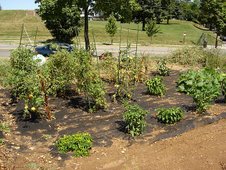I had always heard that soil-testing was a good idea to improve the overall harvest, but I became motivated to actually do this when I heard that urban gardens may be more suspectible to lead contamination. Although the risk is relatively low, it suddenly seemed like a good idea to actually know what my ph level was because lead contamination is less likely to occur above 6.5 ph.
The University of Minnesota's Extension service has a good article that can be found here.
Lead Contamination and Gardens
University of Ohio Extension Office FAQ
Monday, February 25, 2008
Subscribe to:
Post Comments (Atom)


3 comments:
What did you find out after you tested the soil? I have my first community garden plot here in DC and I have wondered the same thing. Thanks for the link to the article on this. Also, what community garden are you a part of here? I have my first plot the one on Blair Road in NW DC and am trying try prepare for it. I think I am going to take your advice and order seeds from Southern Exposure.
March 5, 2008 1:46 PM
The biggest danger of lead in soil is to children, who are not only more easily damaged during formative years but are also more likely to get contaminated soil into their mouths. Lead contamination is most likely to occur near a building that has been shedding lead paint or near a busy roadway where automobiles would have been spewing lead fumes when lead was allowed as an additive in gasoline.
Plants generally do not take up lead to the edible parts, although leafy green vegetables (leattuce, chard, etc.) can be a concern if they are grown in soil with high lead levels. Root vegetables should be peeled and washed.
Post a Comment